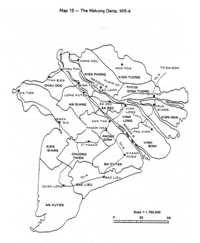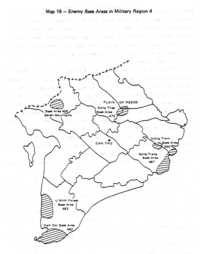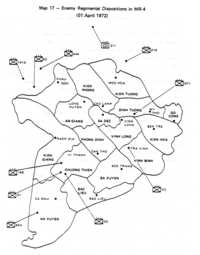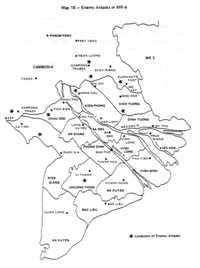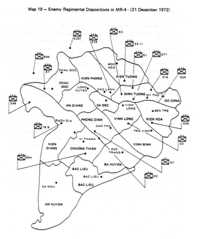|
THE EASTER OFFENSIVE OF 1972 by Lt. Gen. Ngo Quang Truong Published by U.S. Army Center Of Military History
Contents
Glossary
THE EASTER OFFENSIVE OF 1972
CHAPTER VI
Enemy Offensive in the Mekong Delta
The SettingAs major battles of the Easter Offensive began to develop in other military regions throughout South Vietnam, the Mekong Delta remained unusually quiet. But this quietness was deceptive because the enemy maintained at least six regiments within the territory of MR-4 and had the capability to reinforce with the 1st NVA Division located just across the border in Cambodia. Although the enemy's objective in MR-4 was not as clear cut as in other military regions during the initial stage of the offensive, a very plausible theory held that he might contemplate two things. Militarily, he could try to pin down IV Corps forces, the 7th, 9th, and 21st ARVN Divisions, at home, preventing them from being re-deployed to other areas. Politically, he would certainly endeavor to wreck our pacification achievements in the Mekong Delta, and by the same move, strangle its economic lifeline to the nation's capital.
The terrain of MR-4 differed radically from other regions. Flat
and mostly uncovered, it consisted of mangrove swamps and rice
fields crisscrossed by an interlocking system of canals, natural
and artificial. Except for some isolated mountains to the west near
the Cambodian border, few areas in the Delta had an elevation of
more than 10 feet above sea
ARVN forces under the control of IV Corps consisted of three infantry divisions, two mobile and six border ranger groups. In addition, the territorial forces of MR-4 totaled about 200,000, by far the most numerous among the four military regions. The 7th ARVN Division was headquartered at Dong Tam Base in Dinh Tuong Province; the 9th Division was located in Sa Dec and the 21st Division usually operated in the Ca Mau Peninsula from its headquarters at Bac Lieu. Despite the substantial combat support and significant advisory effort, both military and civilian, provided by the United States, primary responsibility for the combat effort in MR-4 had always been Vietnamese, even during the period when U.S. units operated in the Mekong Delta.
To present a comprehensive view of the military situation throughout
MR-4, it is necessary to go back to early 1970. As a result of
COSVN's Resolution No. 9 disseminated in 1969, which emphasized the
strategic importance of the Mekong Delta and conceived it as the
principal battlefield where the outcome of the war in South
Vietnam would be decided, the enemy infiltrated the 1st NVA
Division Headquarters and its three regiments, the 88th, l01D and
95A into MR-4. This effort succeeded despite heavy losses. IV
Corps forces were thrown off balance and the pacification effort
declined as a result of extensive enemy attacks and shellings. Not
until after the enemy's sanctuaries beyond the border had been
destroyed during the Cambodian incursion and his capability to re-
supply from the sea eliminated were these 1st NVA Division forces
compelled to break down into small elements and withdraw. Part of
these elements fell back into mini-bases within MR-4; others
retreated toward Cambodia.
As a result of these achievements, the situation in MR-4 was particularly bright by early 1972. About 95% of the Delta population lived in secure villages and hamlets. Rice production had increased substantially and education was available to every child of school age. Prospects for the Delta's future looked promising as key GVN programs such as Land-to-the-Tiller and Hamlet Self- Development were gaining solid momentum. The four year Community Defense and Local Development Plan that the GVN had initiated in March 1972 presaged an even brighter future for the farmers of the Mekong Delta.
During this time, the defense of the border for MR-4 was assigned to the 44th Special Tactical Zone (STZ) whose border ranger and armor forces were deployed as a screen along the Cambodian border from the Mo Vet (Parrot's Beak) area to the Gulf of Siam. In addition to its territorial defense responsibility inside MR-4, the 44th STZ also operationally controlled two major bases in Cambodia, Neak Luong, at Route QL-l ferry crossing of the Mekong River, and Kompong Trach, some 20 km north of Ha Tien. Both bases were secured by ARVN ranger forces. The 9th ARVN Division was then conducting operations in the upper U Minh area and in Chuong Thien Province while the 21st Division operated in the lower U Minh area and in the southern portion of Cape Ca Mau. Meanwhile, the 7th ARVN Division was responsible for the two contested areas of MR-4, Dinh Tuong and Kien Hoa Provinces, and other provinces sandwiched between the Mekong and Bassac Rivers.
In mid March, an ARVN intelligence report indicated that the
entire 1st NVA Division was moving southward in Kampot Province
(Cambodia), to an area deeper south than where it had been in late
1970. Two other enemy regiments, 18B and 95B, were also reported
leaving the U Minh area and moving eastward in the direction of
Chuong Thien Province. These movements undoubtedly presaged major
actions in the Mekong Delta during the 1972 dry season.
Kompong Trach: The Opening RoadThe battle for Kompong Trach was to have a considerable impact on the military situation in the Mekong Delta for the remainder of 1972. It started 22 March with an engagement between elements of the 42d ARVN Ranger Group and the enemy l01D Regiment and did not abate until the end of April. Kompong Trach was a small Cambodian town located near a road intersection in a lightly forested area north of Ha Tien City, about 15 kilometers north of the border. IV Corps maintained an operational base there which controlled one of the enemy's major supply routes from Cambodia into the Mekong Delta. Apparently, it had not been the enemy's choice to fight a major battle in this area at this time. The initial engagement, however, developed into a significant battle as reinforcements kept pouring in from both sides. The fighting was fierce and tough. On the ARVN side, a large force was committed which eventually consisted of four armored cavalry squadrons, including the 7th Division's organic squadron, deployed across the entire width of MR-4 from its easternmost corner over one hundred kilometers away, six ranger battalions, artillery units and supporting engineer elements. The enemy initially committed only one regiment, the 101D, and supporting elements of the 1st NVA Division Headquarters. Eventually, however, he was forced to throw in two additional regiments in rapid succession, the 52d and E44, which were then on their way into MR-4.
In spite of heavy losses incurred by both sides and the fact that
eventually the ARVN base at Kompong Trach had to be evacuated, this
battle resulted in a major defeat for the enemy. For one thing,
the 1st NVA Division, which was the enemy's single division size
unit committed to the Mekong Delta at that time, had been forced
to exhaust its combat potential on Cambodian soil whereas it was
apparently needed to conduct major actions inside MR-4 in concert
with the offensive in other areas of South Vietnam. Fighting this
battle, the enemy did not succeed in breaking the household china,
his primary objective;
The battle of Kompong Trach took place in an area far removed from our normal supply lines. Access by road and waterway to the battle ground was limited. As a result, IV Corps had difficulty in the movement of troops and supplies for the support of the ARVN effort(1). In fact, the battle was just an exchange of military assets and it did not involve the lives and properties of the Mekong Delta's population.
The Hau Giang Under AttackWhile the battle at Kompong Trach was raging, the enemy initiated offensive activities in the Mekong Delta with a series of attacks on 7 April. Most of these attacks occurred in the province of Chuong Thien. They were conducted by four local main force units, the 18B, 95B, Dl and D2 Regiments, which almost in unison endeavored to destroy all friendly bases and outposts along the enemy's communication routes. These routes originated in the large U Minh base area, ran through the provinces of Chuong Thien and Phong Dinh, then connected the Hau Giang area (the provinces west of the Bassac River) with the Tien Giang area (the provinces east of the Mekong River).
To help maintain tactical balance for MR-4, U.S. tactical air and B-52 strikes, which had not been used in the Delta since the beginning of 1972, resumed in support of ARVN forces at Kompong Trach and in other areas under contest throughout MR-4. This support from the air had a significant impact on the final outcome of the enemy offensive. Without it, it is doubtful that the ARVN ground forces, which fought so well at Kompong Trach, Kien Tuong, at the Elephant1s Foot and in Dinh Tuoung would have been able to defeat so decisively the large enemy forces engaged in these battle areas. At best, ARVN might have been able to achieve a stalemate in some of those engagements. On 7 April, the day enemy attacks began in MR-4, the 21st ARVN Division was ordered to prepare for movement to MR-3. Three days later, the first elements of this division were already deployed along Route QL-13 north of Lai Khe. Then, about a month later, on 12 May, another MR-4 unit, the 15th Regiment of the 9th Division, was deployed to MR-3 in the effort to relieve enemy pressure on An Loc. These redeployments resulted in big voids which would affect the defense posture of MR-4. Consequently, IV Corps had to readjust the tactical areas of responsibility over the entire border area with its mobile and border ranger units, to include a ranger group just released from its reinforcement mission in MR-1. The 9th Division (-) took over responsibility for all the provinces in the Hau Giang (Bassac) area while the 7th Division was given responsibility for the Tien Giang (Mekong) area with the majority of its effort concentrated north of Route QL-4.
In spite of the over extension of its forces and the increasingly
strong pressure coming from the Cambodian border, IV Corps
continued to meet the challenge effectively. Major General Nguyen
Vinh Nghi, who had replaced me as IV Corps commander in early May,
proved to be the man for this challenge because of his familiarity
with the Mekong Delta. His actions were timely and responsive. A
cautious man by
On 18 May, elements of the enemy 52d and l0lD Regiments, 1st NVA Division attacked Kien Luong, a district town in northern Kien Giang Province, some 20 kilometers southeast of Ha Tien. This was the first instance of significant enemy re-infiltration into the Mekong Delta since this division was driven out of the That Son (Seven Mountains) area in April 1971. The battle took place around the cement plant and in the town's market area. Enemy sappers initially succeeded in penetrating and holding the plant's personnel living quarters and a few blocks in town. They quickly organized these areas into solid defense positions. Fighting continued for ten days before ARVN ranger and armor forces, in coordination with local RF and PF units, forced the NVA troops from both areas. Enemy forces withdrew toward the Cambodian border, leaving behind hundreds of bodies scattered among the ruins. After the battle, the situation in the provinces west of the Bassac River returned to normal. The four enemy local force regiments in this area were unable to renew any significant activity, battered as they were by successive B-52 strikes and our constant attacks by ARVN forces. They managed only to harass isolated bases and outposts manned by the RF and PF.
In the meantime, indications were being obtained by ARVN-U.S.
intelligence of a strong enemy buildup in the Parrot's Beak and
Elephant's Foot areas near the border in northern Kien Tuong
Province. These reports pointed toward major actions in the Tien
Giang (Mekong) area for which the 7th ARVN Division was responsible.
Actions in the Tien GiangOn 23 May, a small engagement took place between ARVN ranger and armor forces of the 44th STZ and the NVA 207th Regiment in an area on the Cambodian side of the border1 some 15 kilometers north of Cai Cai, a district town located on the common boundary of Kien Tuong and Kien Phong Provinces near the Cambodian border. During this battle, ARVN forces captured some enemy documents which contained plans for the infiltration of NVA units into northern Kien Tuong Province and subsequent attacks against Moc Hoa, the provincial capital. Then on 10 June, prisoner sources disclosed that the 5th NVA Division - which had failed in its earlier effort to take An Loc in MR-3 - was being re-deployed to the Elephant's Foot area on Cambodian territory. Eventually, this unit was to move into Base Area 470 in the Plains of Reeds. To the IV Corps commander, who had participated in MR-3 operations during the initial stage of the siege on An Loc, it became evident that after being defeated there, the hungry enemy was trying to seek refuge in the food rich Mekong Delta. He was determined therefore to deny the enemy this refuge. Actually, a new phase of the enemy offensive was about to begin that would involve IV Corps forces in major battles not only in the Tien Giang area but also in Cambodia. Within 48 hours, General Nghi moved the 7th Division Headquarters and two regiments into the Elephant's Foot area north of Kien Tuong Province. Soon this division was joined by its remaining elements. At the same time, U.S. tactical air and B-52 strikes repeatedly pounded away at targets of enemy troop concentration in.the area. IV Corps's quick action was timely and effective. It successfully stopped the enemy's effort to infiltrate his major units into MR-4; it also afforded IV Corps more time to consolidate the defense of Dinh Tuong Province which from all indications had been the enemy's choice for refuge and future actions.
Subsequently, several heavy engagements occurred in the Elephant's
Foot area. The enemy had brought along a powerful array of
antiaircraft
But the enemy seemed oblivious to the serious losses he had incurred. He shifted his movement westward, pushing his regiments - two of the 5th NVA Division and the 24th and Z18 - deeper into the Tien Giang area toward Base Area 470 where these units were to join forces with the Z15 and Dong Thap 1 Regiments. By early July therefore, a total of six enemy regiments were reported in northern Dinh Tuong Province, about 65 kilometers southwest of Saigon. Dinh Tuong Province was about to become the area for a major contest, and perhaps this was the primary goal of his offensive in the Mekong Delta. In the meantime, and in conjunction with his effort to infiltrate the Tien Giang area, other NVA units, probably elements of the 9th Division, began moving toward Kompong Trabek which they took in mid June. With the support of local Khmer Rouge units, these NVA forces were endeavoring to tighten control over Route QL-l from the Parrot's Beak area to Neak Luong on the Mekong River. By 2 July, only two towns remained under National Khmer control in this area, Neak Luong and Svay Rieng.
Since the National Khmer forces were unable to dislodge the enemy
from Kompong Trabek, a combined Khmer-ARVN operation was launched
to retake this town. After 22 days of fighting, ARVN forces
succeeded in freeing Kompong Trabek and clearing Route QL-l
westward after a link up with Neak Luong. However, the enemy was
determined to keep this town under his control since it was located
between two of his main supply lines. Consequently, as soon as
ARVN units re-deployed to the Delta, NVA forces would return and
occupy the town. This occurred not once
Attack in Dinh TuongThe enemy took advantage of the void left in Dinh Tuong Province by the 7th ARVN Division, which was then conducting operations in Cambodia. He launched a series of coordinated attacks against three district towns, Sam Giang, Cai Be and Cai Lay during the period from 17 May to 11 July. The attacking forces initially consisted of elements of the Dong Thap 1 and Z15 Regiments. All of these attacks were driven back by territorial forces with the strong support provided by U.S. tactical air and helicopter gunships. The enemy was finally forced to withdraw into his base area (470) to refit and recover for future actions. His losses had been heavy. Despite initial setbacks enemy pressure was also mounting at this time on Route QL-4, the vital supply line between the Delta's rice bowl and the nation's capital. Indications were that the enemy was bringing into the area more troops. As a result, IV Corps had to move the 7th Division back into its tactical area of responsibility, leaving behind only one regiment to form a screen along the border. By that time, the 15th Regiment, 9th ARVN Division had accomplished its mission south of An Loc and was released by MR-3 for return to MR-4. It was immediately deployed to Dinh Tuong at the same time as two ranger groups and the Ranger Command of MR-4. To defeat the enemy's effort against Route QL-4 in Dinh Tuong, B-52 strikes were concentrated on enemy bases in the Delta whenever fighting became intense and profitable targets were detected.
In mid August, as the situation in Binh Long Province became
stabilized, the 21st Division was returned to MR-4 and reassigned
the responsibility for the southern Hau Giang area, its former
territory.
As a result of this influx of ARVN forces in the Tien Giang area, there was an urgent need for IV Corps to provide better command and control. General Nghi therefore established IV Corps Command Forward at Dong Tam Base and placed Brigadier General Nguyen Thanh Hoang, his deputy for operations, in charge. This rather conventional approach to command and control greatly assisted General Nghi. It facilitated the execution of two major tasks that IV Corps had assigned to its subordinate units, namely to maintain contact with the enemy and destroy his units in the Delta, and to interdict his movements of men and supplies from Cambodia into South Vietnam. During this period of command and control restructuring, the ranger forces and 9th Division, which were occasionally reinforced with the 10th and 12th Regiments, 7th Division, fought many fierce battles in Dinh Tuong Province and in Base Area 470. In early August, the ranger forces under MR-4 Ranger Command fought a major battle in the Hau My area, west-northwest of My Tho, and completely cleared this area of the enemy. This enabled IV Corps to rebuild a system of outposts along the Thap Muoi Canal and reestablish GVN control over this area which had been subverted by the enemy since the beginning of his Easter Offensive. By the end of August, enemy activities in Dinh Tuong Province had been seriously impeded by our quick and aggressive reactions on the ground and continuous pounding from the air by U.S. tactical air and B-52's.
In late August and early September, IV Corps shifted its effort
toward the That Son area in Chau Doc Province where intelligence
reports strongly indicated reinfiltration by elements of the 1st
NVA Division.
The AftermathDuring the month of September, the situation in the Delta remained relatively uneventful. Not until early October did enemy initiated actions resume again at a high level. The enemy's increased effort appeared to have some connection with the cease-fire agreement which was being finalized in Paris. In this effort, the 1st NVA Division sent its two regiments, the 42d and l01D, south into An Giang Province and concurrently west into the Ba Hon Mountain area near the coast in Ha Tien Province. East of the Mekong River, elements of the 207th NVA and the E2 Regiments, which were operating in the area of Kompong Trabek and north of Cai Cai, also infiltrated into Kien Phong Province. South of the Bassac River, the enemy's 18B, 95A, Dl and D2 Regiments simultaneously moved eastward, establishing blocking positions along lines of communication and among populous areas. This fanning out pattern clearly indicated an attempt by the enemy to extend his presence over the Delta, undoubtedly in preparation for a standstill cease- fire. However, by the end of October when the cease-fire agreement failed to materialize, these activities declined significantly.
In late October and early November, the 7th ARVN Division made
several contacts with the enemy in Kien Phong Province During a
battle in the Hong Ngu District where the Mekong River crossed the
border, elements of the division, in coordination with territorial
forces, annihilated one battalion of the 207th NVA Regiment,
taking a total of 73 prisoners during eight days of engagement.
This turned out to be the largest single group of enemy prisoners
ever captured during the war Most of these prisoners were teen
agers, ill-fed and ill-equipped, some without weapons or
ammunition. They disclosed that they had been
Along the common boundary of Kien Tuong and Kien Phong Provinces, the 10th Regiment, 7th ARVN Division also harvested repeated success during contacts made with infiltrated elements of the E2 Regiment, 5th NVA Division. These victories were achieved with the significant support of U.S. Army Air Cavalry teams. Finally, an enemy scheme to attack Cao Lanh, the provincial capital of Kien Phong, was preempted by the quick deployment of the 11th and 12th Regiments, 7th Division into this area. Meanwhile, farther west of the Bassac River, ranger forces of the 44th STZ conducted successful operations in Ha Tien Province and the That Son area. During these operations, they captured several supply caches, destroyed enemy installations and inflicted substantial losses to elements of two NVA regiments, the 52d and l01D of the 1st Division. A battalion commander of the 52d NVA Regiment surrendered to the rangers and he disclosed that his battalion had been so severely mauled by our ambushes and airstrikes that only 30 men were left. As of mid December, the overall situation in the Mekong Delta returned to its pre-offensive quietness. IV Corps took advantage of this respite to readjust command and control, expanding the 7th Division's TAOR to include both Dinh Tuong and Go Cong Provinces as the first step. The 9th Division was then assigned responsibility for the provinces of Sa Dec, Vinh Long, Vinh Binh and Kien Hoa. This extension of ARVN forces brought about an improvement in territorial security, especially in those areas where enemy pressure was heavy and our territorial forces needed ARVN support.
In summary, in spite of his multiple efforts and heavy sacrifices during the Easter Offensive, the enemy accomplished very little in the Mekong Delta. Route QL-4, which was one among the enemy's major objectives, remained open throughout his offensive save for brief periods of traffic interruption. He had failed to strangle our vital lifeline; he had also failed to disrupt our pacification effort. No district town, not even the remotest, be it in Kien Hoa, Ca Mau or along the border, ever fell into enemy hands, even temporarily. Despite some ups and downs in the pacification effort, the enemy was unable to achieve any additional gains in population control. And most remarkably, all our lines of communication, roads or waterways, remained trafficable throughout his offensive.
On their part, the ARVN forces of MR-4 had performed remarkably
well. They had effectively prevented the enemy from achieving big
gains and had finally defeated him soundly, this despite their
initial failure to prevent further infiltration. The
accomplishments of the 7th and 9th Divisions, the rangers, and the
RF and PF in the Mekong Delta, although not as dramatic as the
combat exploits achieved in heroic An Loc, proud Kontum or
victorious Tri-Thien, certainly did have a decisive impact on the
survival of South Vietnam. Our strategists had always emphasized
that, "He who won the battles in the Mekong Delta would win the war
in South Vietnam" Not only had IV Corps won the battles in the
Mekong Delta but it had done this while sharing nearly one half of
its forces with MR-3 and MR-l.
(1) IV Corps Headquarters and almost all support units were located in Can Tho, the focal point of MR-4.
|
